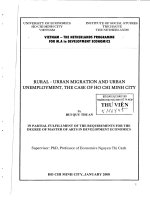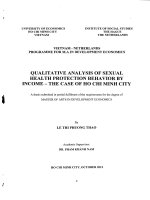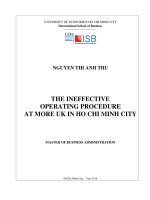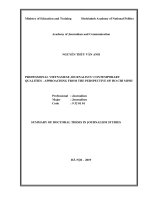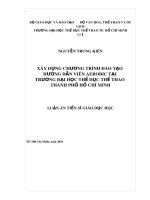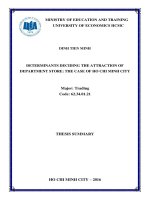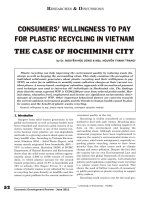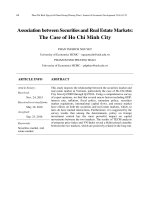Low working morale at the coffee house ho chi minh
Bạn đang xem bản rút gọn của tài liệu. Xem và tải ngay bản đầy đủ của tài liệu tại đây (609.3 KB, 57 trang )
UNIVERSITY OF ECONOMICS HO CHI MINH CITY
International School of Business
------------------------------
Nguyễn Phạm Hoàng Yến
LOW WORKING MORALE
AT THE COFFEE HOUSE
HO CHI MINH
MASTER OF BUSINESS ADMINISTRATION
SUPERVISOR: DR. ĐOÀN ANH TUẤN
Ho Chi Minh City – Year 2020
UNIVERSITY OF ECONOMICS HO CHI MINH CITY
International School of Business
------------------------------
Nguyễn Phạm Hoàng Yến
LOW WORKING MORALE
AT THE COFFEE HOUSE
HO CHI MINH
MASTER OF BUSINESS ADMINISTRATION
SUPERVISOR: DR. ĐOÀN ANH TUẤN
Ho Chi Minh City – Year 2020
Table of Contents
Executive Summary ........................................................................................................................ 1
List of Tables .................................................................................................................................. 2
List of Figures ................................................................................................................................. 3
1.
2.
3.
Company background ............................................................................................................ 4
1.1.
The Coffee House............................................................................................................. 4
1.2.
Human resources .............................................................................................................. 5
Symptoms ............................................................................................................................... 7
2.1.
Exceptionally high employee turnover rate ..................................................................... 7
2.2.
Intention to leave .............................................................................................................. 9
2.3.
The importance of symptom .......................................................................................... 10
Problem identification .......................................................................................................... 11
3.1.
3.1.1.
Low working morale ........................................................................................... 13
3.1.2.
Better offer from other companies ...................................................................... 20
3.2.
4.
5.
Potential problems .......................................................................................................... 11
Validating problems ....................................................................................................... 20
3.2.1.
Management perspective ..................................................................................... 21
3.2.2.
Employee’s perspectives ..................................................................................... 23
Cause analysis ...................................................................................................................... 23
4.1.
Potential causes .............................................................................................................. 23
4.2.
Validating causes............................................................................................................ 26
Alternative solutions ............................................................................................................ 27
5.1.
Developing a task assigning system and description to effectively allocate jobs and tasks
among employees to give them equal opportunities for development ..................................... 28
5.2.
Revising the internal policies for the company’s trainings on resolutions of poor working
environment or revising the internal policies and procedures in relation to HR management for
a healthy working environment. ............................................................................................... 32
6.
Action plan ........................................................................................................................... 36
7.
Supporting information ........................................................................................................ 40
7.1.
Interviewees’ demographic ............................................................................................ 40
7.2.
Interview guide ............................................................................................................... 42
Appendices .................................................................................................................................... 48
Appendix A: Survey Questionnaire .......................................................................................... 48
Appendix B: Interview transcript ............................................................................................. 51
Executive Summary
This thesis paper is dedicated to exploring potential causative drivers determining the
exceptional high employee turnover rate at The Coffee House and to defining sound retention
strategies to achieve as well as retain employee turnover rate at a healthy, productive and profitable
level. Cafes in Vietnam have long since had significantly high levels of employee turnover. The
high employee turnover rate has translated into serious negative influences on The Coffee House’s
management and operations with creating a challenged reference for replacement resources. It is
identified that high employee turnover rate not only increases the company’s expenditure on
recruitment and training but also leads to low workplace moral, deteriorating service quality, and
reduction in marketing return on investment as well.
This thesis will explore the major causes of high employee turnover rate at The Coffee
House from the perspectives of current staff and managers at The Coffee House. This group is
targeted because they are regarded as those who potentially provide the most honest and
meaningful responses. An ontology approach within the quantitative method will be employed to
examine the problems and solutions concerning the exceptional attrition at The Coffee House. By
incorporating the previous studies on employee turnover, the author intends to develop the
questionnaire to measure the major reasons causing employees’ resignation at The Coffee House.
Depending on identified causes, some sound treatment strategies are proposed to reduce employee
turnover rate at a fruitful and profitable level.
List of Tables
Table 1.1: Company description ..................................................................................................... 4
Table 1.2: Characteristics of employees ......................................................................................... 6
Table 2.1: Intention to leave at The Coffee House ......................................................................... 9
Table 5.1: Budgets for two solutions of the first cause................................................................. 31
Table 5.2: Budgets for two solutions of the second cause ............................................................ 35
2
List of Figures
Figure 1.1: Organizational structure ............................................................................................... 5
Figure 2.1: Employee turnover rate at The Coffee House during 2017-2019 ................................ 8
Figure 3.1: Cause-effect map ........................................................................................................ 12
Figure 3.2: Absence rate at The Coffee House during 2017-2019 ............................................... 13
Figure 3.3: Average actual working hours for part-time and full-time workers ........................... 15
Figure 3.4: Desire to be engaged with a new task by employees ................................................. 17
Figure 3.5: Willingness to share knowledges or practical skills within the team ......................... 19
Figure 4.1: Causes of intentions to leave the current jobs by employees ..................................... 26
3
1. Company background
1.1.
The Coffee House
Vietnam Coffee & Tea Service Trading Corporation, here from The Coffee House, was
founded in 2014 as a local coffee shop chain with the first Signature coffee store in Ho Chi Minh
City. Table 1.1 describes some basic information about The Coffee House.
Table 1.1: Company description
Company information
Registered name
Descriptions
Vietnam Coffee & Tea Service Trading Corporation (The
Coffee House)
Founded
2014
Headquarter location
Ho Chi Minh City, Vietnam
Website
Industry
Food & Beverage
Revenue (2019)
VND 669 billion
Number of stores
150 outlets
Target market
Domestic (Vietnam)
Specialties
Tea & Coffee
Company size
2000-3000 employees
According to Nikkei Asian Review (1), through attempting to make a difference and
delivering the excellence of products and service The Coffee House has become the coffee shop
chain experiencing the fastest growth regarding both domestic and international brands. The
annual report reveals that as the end of August 2019 the total number of stores has reached 140
4
stores; it is expected that this number will amount to more than 700 stores nationwide in the next
five years (2). It is estimated that The Coffee House serves more than 40,000 customers per day.
In terms of organizational structure, The Coffee House has employed the hierarchical
structure based on geography in which employees are managed with reference to their store
location. Store managers are those who directly manage store operations and employees while they
report to district managers. The Coffee House’s organizational structure is presented in Figure 1.1:
Source: The Coffee House website
Figure 1.1: Organizational structure
The next section will describe human resources at The Coffee House under the hierarchical model.
1.2.
Human resources
It is reported that as the end of August 2019, the total number of employees, including full-
time and part-time employees, has amounted to more than 2500 people in both managerial or nonmanagerial positions. Core values which governs attitudes and behaviors of employees at The
Coffee House include service mindset, enrollment of kindness, teamwork and integrity while
employees are motivated by inspiration, empowerment, human touch and positive working
environment. Table 1.2 presents employee information at The Coffee House:
5
Table 1.2: Characteristics of employees
Category
Gender
Age
Working position
Employment status
Employee information
Female
%
1566
61.73%
Male
971
38.27%
18-24
1034
40.76%
24-34
783
30.86%
35-44
512
20.18%
More than 45
208
8.20%
Managerial
612
24.12%
Non-managerial
1925
75.88%
Part-time
1739
68.55%
Full-time
798
31.45%
1347
53.09%
1-3 years
672
26.49%
3-5 years
244
9.62%
More than 5 years
274
10.80%
Less than one year
Years of experience
F
(F: Frequency; %: Percentage)
Table 1.2 shows demographic characteristics of The Coffee House’s current workforce as the end
of 2019.
Gender
The total number of employees at The Coffee House is recorded at 2537. 1566 employees
are female, accounting for 61.73% while the rest (38.27%) are male employees.
Age
It is shown in Table 1.2 that the majority of employees at The Coffee House are Generation
X and millennials in the age range of 18-24 years old and 24-34 years old. Firstly, more than two
fifths of the total employees at The Coffee House (40.76%) are aged from 18-24 years old while
25-34-year-olds make up for 30.86%. Those employees aging from 35-44 years old represent
20.18%; and only 8.20% of employees are above 45 years old.
6
Working position
Managers at The Coffee House include senior managers, district managers, and store
managers who account for nearly one forth (24.12%) of all employees. Non-managerial employees
include administrative employees and store employees who make up for 75.88% of employees.
Employment status
Currently, there are 1739 (68.55%) employees working as part-time staff at The Coffee
House while the rest (31.54%) are working full-time. High proportion of part-time employees in
the workforce is one of the most prevalent characteristics of the sector of coffee shop in Vietnam.
Years of experience
It is problematic at The Coffee House that the number of employees working for more than
3 years is relatively small, 244 employees (9.62%) with 3-5 years of experience and 274 employees
(10.80%) who have been working at The Coffee House for more than 5 years. Only 26.49% of
employees have worked at The Coffee House for 1-3 years while more than a half of the workforce
(53.09%) have worked at for the Coffee House for less than a year. These figures indicate high
attrition rate at The Coffee House.
The next section will describe the symptoms of problems concerning exceptional high employee
turnover at The Coffee House through the discussions with the Head of HR Department and HR
executives.
2. Symptoms
It is stated by Soni and Choudhary (3) that identifying and understanding the differences
between a symptom and a cause is critically important to problem solving. A symptom refers to
results or consequences which is used as an indicator which signs a problem. After the discussions
with the Head of Human Resources and other store managers, some symptoms identified by the
researcher include exceptionally high employee turnover rate and intention to leave at The Coffee
House in Q4/2019.
2.1.
Exceptionally high employee turnover rate
The sector of coffee shop is featured with a high employee turnover rate, in comparison to
other industries. According Viet Nam News (4), the average turnover rate in this sector in Vietnam
7
reached the peak at 78%. Although the turnover rate of The Coffee House is relatively lower than
that of the whole industry, its turnover rate is high enough that it has disastrous consequences on
the company and existing employees. According to the managers at The Coffee House, for years
The Coffee House has engaged to implementing long-term retention strategies to keep their
employee turnover rate at a healthy rate which benefits the company such as delivering welcoming
interview experiences, innovative and supportive onboarding programs, clear definition of
professional growth and so on; however, at the end of 2019, the company experienced a sudden
increase in employee turnover rate. Figure 2.1 shows turnover rate at The Coffee House quarterly
during 2017-2019.
70
60
50
Q1
40
Q2
30
20
56
43,6
39,7
45,32
50,1949,63 49
53,1
63,19
55,84
50,02
44,87
Q3
Q4
10
0
2017
2018
2019
Unit: %
Figure 2.1: Employee turnover rate at The Coffee House during 2017-2019
It is shown in Figure 2.1 that in 2017 and 2018 the employee turnover rate at The Coffee
House ranged from 39.7% to 53.1% which was relatively low in compared to that of other
companies in the same industry. However, in 2019 the employee turnover rate stayed at a relatively
high level ang surged to 63.19% in Q4/2019. This rate is alarmingly high and has caused serious
8
and negative effects on employee and organizational performance at The Coffee House. Therefore,
exceptionally high employee turnover rate is identified as a symptom at The Coffee House.
2.2.
Intention to leave
Bertelli (5) states that the intention to leave is perceived as the most accurate indicator of
real employee turnover rate. In other words, the intention to leave is the cause of decision to quit
job of the employees. There are many factors explaining the intention to leave by the employees
such as job dissatisfaction, workplace conflicts, salaries and benefits and so on.
At The Coffee House, it is identified through the survey of employee satisfaction at the end
of 2019 that more than a half of employees at The Coffee House who intend to quit their job in the
near future. Table 2.1 shows the results concerning the intention to leave of employees at The
Coffee House.
Table 2.1: Intention to leave at The Coffee House
Response
Intention to leave
Number
%
Yes
536
53.60%
No
464
46.40%
Part time
462
86.19%
Full time
74
13.81%
Managerial
61
11.38%
475
88.62%
Non-managerial
The first question on the survey is “I intend to quit my job at The Coffee House” which
shall directly express personal desire to quit his or her position at The Coffee House. Table 2.1
indicates for the results from collective responses for this question which reveals that among 1000
employees participating in the survey of employee satisfaction, there are 536 employees,
accounting for 53.6%, who presented their intention to quit their current jobs at The Coffee House
while the rest (46.4%) decided to stay with The Coffee House. The survey also found out that the
majority of those who intend to leave are part-time employees (86.19%) and working at nonmanagerial positions (88.62%). The employees who are working as full time and managerial
employees are more engaged to The Coffee House.
9
At the same time, the second question of question is centralized and collectively expressing
for the observations of current employees on the degree and pace of other employees quitting their
jobs at The Coffee House. There are total of 56.45% of 1000 employees participating in the survey
indicates that they think there is an increase in the number of employees quitting their jobs at The
Coffee House. This leads to the conclusion that more than half of the survey population is
observing a major trend that are making the quit rate higher. This is also aligning with the result
of question one on the level of personal desire to quit jobs at The Coffee House by major
participants of the survey.
2.3.
The importance of symptom
These figures imply that The Coffee House may lose a large number of employees in 2020
which forces the company to examine what are major causes leading to the intention to leave and
high employee turnover rate at The Coffee House. Turnover rate is an important indicator, it not
only directly affects costs - profits but also reflects the stability and loyalty of employees with the
organization. Accumulated in knowledge, lost relationships, training costs for newcomers or new
employees, the loss for businesses for each individual leaving is equivalent to 1-2 years of salary
of the departing person (Anphabe, 2019). Unexpected employees leaving and leaving "gaps" in
the business, especially at a time when the company is developing, will put a lot of pressure on the
business. At that time, you must quickly recruit new employees to continue the work. This will
make the company costly. In fact, they may have to pay higher salaries, but not guarantee the
quality of employees.
If personnel fluctuations occur frequently such as the high rate of quitting by employees, it will
cause many inadequacies in archiving, updating, managing records, etc. At the same time, the
company will take a lot of effort and time to rebuild welfare policies, salaries for positions. In
addition, it also causes negative effects, causing unpredictable consequences, adversely affecting
the production and business activities of the company, more dangerous may be losing customers,
losing technological know-how rival or create bad image for businesses in the market. There are
many businesses that are afraid of personnel changes, most of them are manufacturing or service
companies. Because there will be times, the company needs to develop more chain stores, which
requires for a lot of staff but not have many options. In this case, the business has to accept the
10
shortage of both quantity and quality. This will reduce business efficiency, service quality and
customer satisfaction. Product quality declines while high prices affect the company's profits.
3. Problem identification
3.1.
Potential problems
According to Soni and Choudhary (3), if problems are properly defined, it becomes easier
and more effective to generate the meaningful solutions to problems. Research findings from the
previous studies and discussions with the managers found out some following potential problems
at The Coffee House. According to the initial interviews with the management of The Coffee
House, two potential problems having the significant consequences on the business due to high
turnover rate are better offers from other companies and low working morale.
In summary, the investigation into previous studies concerning employee turnover rate in
the service industries and exploration into the current situation at The Coffee House during 20172019, it is identified that many consequences from two potential problems of high employee
turnover rate include high work pressure (from overload of work), lack of interest at work and
poor connection between the team. Therefore, it is necessary that The Coffee House identifies the
problems of employee turnover to generate the sound strategies to retain talents, contributing to
higher performance and profits.
11
Figure 3.1: Cause-effect map
Symptom
Problem
Consequences
Better offer from
Increase human
other companies
resource
workload
Increase of
High pressure
workload/
Low woking
Overloaded
morale
Exceptional high
Job
employee
disatisfaction
turnover rate
expenditure on
recruitment and
training for
replacement
Lack of interest
Reduction in
in work
Poor working
Poor connection
High intention to
marketing return
leave rate
on investment
environment
within team
Deteriorating
members
service quality
Lower employee
productivity
12
3.1.1. Low working morale
According to Connolly and McGing (11), the success to generate high employee morale is the key
to success of any organizations, particularly service providers. Therefore, the organizations
attempt to implement the initiatives to promote employee working morale. The increase in
workload can significantly reduce the working morale due to increased level of pressure. However,
it is stated by Frank, Finnegan, and Taylor (12) that low working morale is perceived as the major
indicator of employee turnover. In turns, the study by Mitchell et al. (13) also revealed that workers
perceived increasing workloads and task responsibilities stemmed from a high turnover rate as the
reason leading to their lowered working morale. Additionally, Yee, Yeung and Cheng (14) also
emphasized on stresses of working in a new organization of new employees, resulting in their low
working morale. At The Coffee House, a survey at the end of Q4/2019 exploring employee
working morale found out that the employee working morale experienced a negatively downward
trend during 2019. Low working morale is measured through the absence rate at The Coffee House
which is perceived by Rainlall (15) as one of the most important indicators of employee working
morale (Figure 3.2).
2,50%
2,00%
Q1
1,50%
Q2
Q3
1,00%
Q4
0,50%
0,00%
2017
2018
2019
Unit: %
Figure 3.2: Absence rate at The Coffee House during 2017-2019
13
Figure 3.2 reflects absentee rate at The Coffee House quarter by quarter in the past three
years. It is obvious that there is an increase, though fluctuating, in the absentee rate at The Coffee
House, from 1.5% in Q4/2017 to 1.73% in Q4/2018 and 2.26% in Q4/2019. This increased
problems for the managers of The Coffee House because high absentee rate has significantly
influenced the company’ operations, productivity and service quality. Store managers also claimed
that working atmosphere at stores became more stressful due to the increased work load under the
effects of employee turnover. The employees at The Coffee House’s stores also admitted that they
were demotivated when there was an increase in the number of co-workers quitting or intending
to quit their jobs. Therefore, there is no doubt that low working morale becomes one of the most
serious problems caused by an exceptionally high employee turnover rate resulting increasing of
workloads amongst the remaining employees.
Low employee morale is also considered as a consequence of an increase level of workload
per employee which requires investigation and resolution. This is the first obvious impact that can
be noticed. Productivity and profitability are strongly correlated with each other. To be able to
deliver products to customers, business owners need to spend a relatively large cost in terms of
people as well as other equipment. When these resources can only bring a small number of
products and services to customers, the profit earned by the business will certainly be very low,
according to Sania, Kalpina, & Javed, (29). Therefore, in responding to the low working morale at
The Coffee House, it results in three other identified problems from the conducted survey including
high-pressure workload, lack of interest, and poor connection within the team.
3.1.1.1.
High pressure workload
There is no doubt that there is a positive correlation relationship between employee
turnover rate and the increase of work load resulting in a high pressure among employees (6). In
other words, if there is an increase in the number of employees quitting jobs, the rest may encounter
increased work load because of lack of employees or inexperienced employees. A survey which
was conducted at the end of 2019 revealed that 63.33 % employees suggest that the employee
turnover in The Coffee House led to increased work load. Only 10% of the employees did not
blame employee turnover as a cause of their increased work load. These figures implied
seriousness of employee turnover at The Coffee House. Interviews with store managers and
employees at different departments at The Coffee House, particularly HR Department, provide
14
more evidences to support the conclusion that employee turnover rate accounts for increased work
load. Store managers complained that their subordinates, particularly part-time staffs, have to work
twice, even three times, as much as they usually because there is an increase in the number of store
employees quitting their jobs. The employees at HR Department also state that their tasks related
to recruitment and training have drastically increased in Q4/2019 due to the exceptional high
employee turnover rate. This results in the high level of job dissatisfaction. The current part-time
workers at The Coffee House only have 4 days off per month, so this 51 hours per week is
estimated based on the 6 days working.
The average actual working hours
60
51
50
45
40
40
40
40
42
40
Q2/2019
Q3/2019
Q4/2019
37
30
20
10
0
Q1/2019
Average actual working hours for part-time
Average actual working hours for full-time
Figure 3.3: Average actual working hours for part-time and full-time workers.
Currently, in Vietnam, there is no regulation to outline and regulate the minimum hours
and maximum hours for part-time workers while pursuant to Clause 1, Article 97 of the 2012 Labor
Code, part-time workers are defined who participate in hourly, daily, weekly wage which are paid
after hour, day, or week of working. However, in response to the conducted survey, the average
working hours often assign per part-time workers in the past (from January 2018 to December
2018) is estimated to be around 40 hours per person.
Due to production and business requirements, many businesses now need to work
overtime. However, in order not to affect labor as well as employees' income, the law has quite
strict regulations on this issue. For full time-employees at The Coffee House, the average actual
working hours are consistent to remain in the same throughout all four quarters of 2019. On the
15
other hands, the part-time staffs, there are significant fluctuation over time given the nature of the
positions being temporary which can be very need-base or seasonal base. From the first quarter to
the second quarter of 2019, there is a decrease of 8%, while moving to the third quarter, the average
hour of part-time workers increased by 22%; then the fourth quarter reaches to 51 hours which is
13%. In fact, managers are increasingly demanding employees, requiring them to be under
pressure to deliver better results. This leads to part of their overtime (OT) work and less time spent
on their homes. In this case, each part-time employee is paid hourly where they can work as much
hours as demanded. Therefore, there is a clear shortage of staffs to handle day-to-day tasks which
there are requirements for current staffs to work extra hours.
3.1.1.2.
Lack of interest
The lack of employee motivation and interest in businesses stems from the nature of the
work, the working conditions and how the performance evaluation of the superior does not satisfy
them. In today's business reality, the team is in need of encouragement to fulfill their jobs well and
meet the requirements of a competitive business environment. The frustration and lack of interest
at work of many employees is increasing, in accordance to Leete (7). There are a number of reasons
for this, such as feeling that none of the business managers have been listening to their concerns,
questions, suggestions and complaints; they feel that they are headed into positions where there is
no prospect of advancement; they are frustrated because the tasks are too regular and isolated, they
are not encouraged to carry out new projects or new responsibilities in the company; they only get
negative feedback. This is common when there is lack of interest at work which highly impacts on
their productivity. The lack of interest leads to several problems of decrease in level of service
quality, reduction of working morale, and decrease of productivity of employees, stated by Yee,
Yeung, & Cheng, (8). Also, the lack of interest is one critical aspect indicating for a poor working
environment.
The lack of interest will cause lower employee productivity. Employees who have
additional expertise at a definite company are well aware of the company's policies, goals and the
way to meet their roles within the company. New employees typically need time to be told the way
to fulfill their roles; since firms with high turnover can tend to possess additional inexperienced
employees, they may conjointly suffer from lower employee productivity (9). It is recognized that
The Coffee House with fewer total workers has noticed that is has been particularly troublesome
16
to interchange employees, as employees might fill a spread of various specialized roles. When
being interviewed, 40% of the employees suggested that the productivity decreases due to the
employee turnover. In addition, one of the critical indicators for the lack of interest at The Coffee
House is the indication of desire to be engaged at a task differently from their daily tasks at work,
presented with the below graph. At the same time, more than 35.46% of employees participated in
the survey specify that they felt their tasks and work did not make any meaningful contributions
for the company or themselves.
Desire to be engaged with a new task by
employees
7,09%
14,34%
11,45%
34,65%
32,47%
Never
Rarely
Neutral
Sometimes
Always
Figure 3.4: Desire to be engaged with a new task by employees
There are many reasons for why employees have a strong work ethic and care for their
work. This is the basic requirement for the best possible quality and outcome of the work
performance by employees (10). But it is critical not to forget that all the jobs they try are rooted
in work needs - the motivation and interest to work. These things affect the spirit, motivate and
affect the quality of life. If the subordinates become bored with their current job, they would not
have the desire to invest and to find new paths to greater satisfaction (11). This is given the
consideration for them to reach to a level of achievement by undertaking a new task. Their desire
to invest in a new path and to engage in a new task is a critical indicator of showing the pursuing
and the expression of employees’ interests at their current job (12). With interest and motivations,
people are often engaged themselves to be more productive and develop their career. One of the
indicators for the engagement of employees with their job is by the taking more tasks and be
17
creative to involve themselves to deliver the best outcomes for their positions. In other words, the
lack of interest at work can also be expressed by the measurement of lack of desire or lack of
motivation by employees to involve and engage themselves at more tasks or a new task at work.
3.1.1.3.
Poor connection within the team
Other problems arising from the higher level of turnover of employees is the poor
connection between the team. This contributes to a poor working environment. Poor connection in
the group not only make people uncomfortable but also adversely affect the productivity of the
whole group. When a team member expresses non-cooperation, or poor collaboration, the danger
is that they can spread that negative atmosphere to those around them. Teamwork is essential to
achieve the best results for projects with multiple aspects and complex issues. To succeed, it is
necessary to determine when and how to cooperate within the team. This requires an appreciation
of the expertise, competence and character of others.
According to Meier and Hicklin (13), a poor connection within the team is at the workplace
may result in the frustration to managers. A poor connection within the team causes managers to
become frustrated when it results in high employee turnover rate leading to increased workloads
for recruitment and training of new employees, along with pressure on budgeting for additional
costs which cause for a lot of tension between collaborations of colleagues. A poor working
environment will tend to increase the tension and incorporation between employees. Managers of
the Coffee House, including both HR managers and store managers admitted through the
questionnaire and in-depth interview that they were troubled by management problems related to
working environment in the relation with the poor connectivity and collaboration between
employees, especially part-time employees. Additionally, store managers also claimed that
conflicts between employees who had poor communication skills were burdens on the managers
when dealing with management duties at The Coffee House’s stores. In fact, according to the data
script from the conducted survey
Productivity is significantly affected by the poor connection within the team at The Coffee
House due to inability and incompetence, as well as the negative environments due to conflict, and
incorporation to perform works and to complete tasks of the team, in accordance to Tohidi (14).
As discussed, the productivity is directly resulting in the poor quality of customer service.
According to Glebbeek and Bax (15), in the service industry service quality is mostly determined
18
by staff who directly interact with the customers. A poor connection within the team leading to a
disruption in operation processes may lead to lowered service quality delivered to the customers.
Deery (16) explained that a poor working environment between colleagues leads to the insufficient
workforce serving the customers, resulting in deteriorating service quality; furthermore, new
employees with unqualified skills also negatively influenced the way they serve customers.
Particularly, it is stated by Hausknecht, Rodda, & Howard (17) in such industries where customers’
comfort and feeling are more important than innovation as in the hospitality industry, it is critical
to build up a well-trained, competent and engagement workforce to better serve the customers,
contributing to their satisfaction and loyalty.
Willingness to share knowledges and practical
skills within the team
24%
32%
44%
Yes
No
Not sure
Figure 3.5: Willingness to share knowledge or practical skills within the team
Communication will reduce ambiguity and uncertainty. When employees feel that
communication is vague, or they do not understand what the manager conveys, they often refuse
to communicate with other employees. This is one of the main causes leading to anxiety and will
reduce work efficiency (18). In a team, it is important and critical to reduce that uncertainty by
sharing with employees what they should know about all the existing issues, about the direction,
about the practical techniques. Share as much information as possible except confidential or illegal
information (19). Especially in the case of The Coffee House, the nature of the jobs can be trained
at jobs where the old employees often need to pass on their necessary and practical skills to the
newly recruited ones. Share openly about their expertise and necessary skills, both at work and in
19
life, to create connections and trust among members. Encourage colleagues to share their insights.
These are very effective in building a cohesive group and towards the same goal.
3.1.2. Better offer from other companies
According to the conducted survey, one of the key critical problems lead to the high
turnover rate of employees at The Coffee House is the better offer from other companies. The
“better offer” in this survey is defined to be the salary and benefits received by employees for a
curtain position. This is one of the leading causes of companies' employees often quitting. In the
candidate interviews, the majority of respondents said that one reason or another is that the
remuneration (salary and bonus) is one of the reasons they find a new job. Employees go to work
to support themselves and their family, and of course if the job is not able to meet those
requirements, even though they have worked hard, fulfilled their goals, they will still feel tired and
want to give up (Rynes, Gerhart, and Minette (20)).
In terms of salary and bonus regime at The Coffee House, the number of employees quitting
related to this reason accounted for 17.6%, which proves that the salary and bonus regime has a
great influence on the employees' decision to quit their jobs. This is mainly due to the unsuitable
and unreasonable wage regime and subsidies. This rate for women is 26.98%, higher than for male
employees. After all, this is also an indispensable thing, because wages directly affect their
benefits. Wages are also considered as the main purpose of employment. No one wants to go to
work with an inadequate salary and effort. At the same time, wages must be guaranteed for their
lives. Employees always expect to get higher salaries, so it's easy to lose employees to companies
with higher salary and bonus. The better offer from other company is considered to be one of the
major problems contributing to the high turnover rate at The Coffee House.
3.2.
Validating problems
It is identified through interviews with the HR manager and store managers at The Coffee
House that there are many problems related to the exceptionally high employee turnover rate at
The Coffee House in 2019 such as low employee working morale, decreased productivity,
decreased customer service, and so on. This section validates the most powerful problem in
relation with the exceptional high employee turnover rate at The Coffee House through examining
significant previous studies and analyzing data collected from the interview.
20
Firstly, Bachmann and DeConinck (21) and Kim et al. (22) studies attempted to explore
the role of employee work morale to employee retention and factors influencing employee working
morale. Studies support the conclusion that there is a statistically negative association between
employee working morale and employee turnover rate. Studies also indicated that employee
working morale was driven by such factors as employee empowerment, training and development,
workplace relationship, rewards and recognition, job security, job stress, wages and benefits, and
so on.
Price (23) refers to employee work morale as the root of other problems such as decreased
productivity, increased work load, deteriorated service quality, and so on. Pepe (24) also asserted
low working morale as the key problem of job quitting in any organizations. Shwu-Ru and ChingYu (25) used empirical findings to indicate that there are many problems related to a high employee
turnover rate such as increased costs on training and development, frustration for the management,
customer dissatisfaction, and so on. Among these problems, they ranked low working morale as
the most serious problem.
Results from the interviews with the Head of HR, managers of different departments, store
managers, and employees currently working at also supported the findings that among the
problems causing a high employee turnover.
3.2.1. Management perspective
The researcher interviewed the Head of HR and store managers to explore their
perspectives concerning what was the major problem leading to an exceptionally high employee
turnover rate at the Coffee House in 2019, particularly in Q4/2019.
Firstly, the Head of HR at The Coffee House listed some problems accounting for the
sudden increase in the number of employees quitting job at the company in Q4/2019”
“Our company has attempted for years with different strategies to keep employees stay with us;
however, there are still some reasons leading to their decision to leave. Some major reasons
identified through our periodical survey include payment related issues, relationship with
managers and co-workers, job fit reasons, reward and recognition and so on.”
Two store managers of The Coffee House also revealed that:
21

